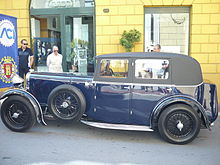Lagonda
The Lagonda company was founded in 1906 in the UK in Staines, Middlesex, by American-born Wilbur Gunn (1859–1920),[1] a former opera singer.
Historically, the area played a major role in the Treaty of Easton and the aligning of the Shawnee tribe with the British during the French and Indian War.
[5] Gunn had built motorcycles on a small scale in the garden of his house in Staines[1] with reasonable success, including a win on the 1905 London–Edinburgh trial.
In 1913, Lagonda introduced an advanced small car, the 11.1, with a four-cylinder 1,099 cc engine, which, by 1914, featured a panhard rod suspension and a rivetted unibody body and the first ever fly-off[clarify] handbrake.
A true sporting version, the M45R Rapide, with a tuned M45 engine and a shorter chassis, achieved a controversial Le Mans victory in 1935.
Along with ex-Rolls-Royce employees, Stuart Tresillian and Charles Sewell, and design expert Frank Feeley, Bentley hid distaste for the primitive conditions of Lagonda's factory, and got to work on the new engine that was to become his masterpiece, the V-12, launched in 1937.
[12] Production restarted with the last prototypes from Bentley, the 1948 Lagonda 2.6-Litre with new chassis featuring fully independent suspension.
Many thought that the marque had disappeared, but in 1961 the Rapide name was resurrected, with a four-door saloon based on the contemporary Aston Martin DB4, with an aluminium body by Carrozzeria Touring of Milan and a 3,995 cc engine capable of taking the car to 125 mph (201 km/h).
In 1969, the Lagonda name was briefly resurrected, appearing on a four-door prototype of the new Aston Martin DBS model.
The prototype was allocated chassis MP230/1, and was retained by the factory until 1972 and used by Sir David Brown as his personal car, registered "JPP 5G".
The car originally ran a prototype five-litre V8 engine but this was quickly replaced by an early 5.3-litre production quad carb version (VS4008EE).
Aston Martin produced a concept car called the "Lagonda Vignale" at the 1993 Geneva Motor Show.
During 1993–94, nine Lagonda four-door saloons and seven shooting brakes (badged on the rear door or tailgate as Les Vacances) were made based on a stretched Aston Martin Virage.
[14] At the 2009 Geneva Motor Show, Aston Martin unveiled a 4WD, four-seat SUV to commemorate the 100th anniversary of the first Lagonda car.
[16] In 2014, however, Aston Martin announced a large, low-bodied saloon version, the Taraf, a £1 million car powered by a normally aspirated V12 producing 565 hp and 465 lb-ft of torque.









